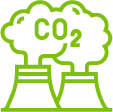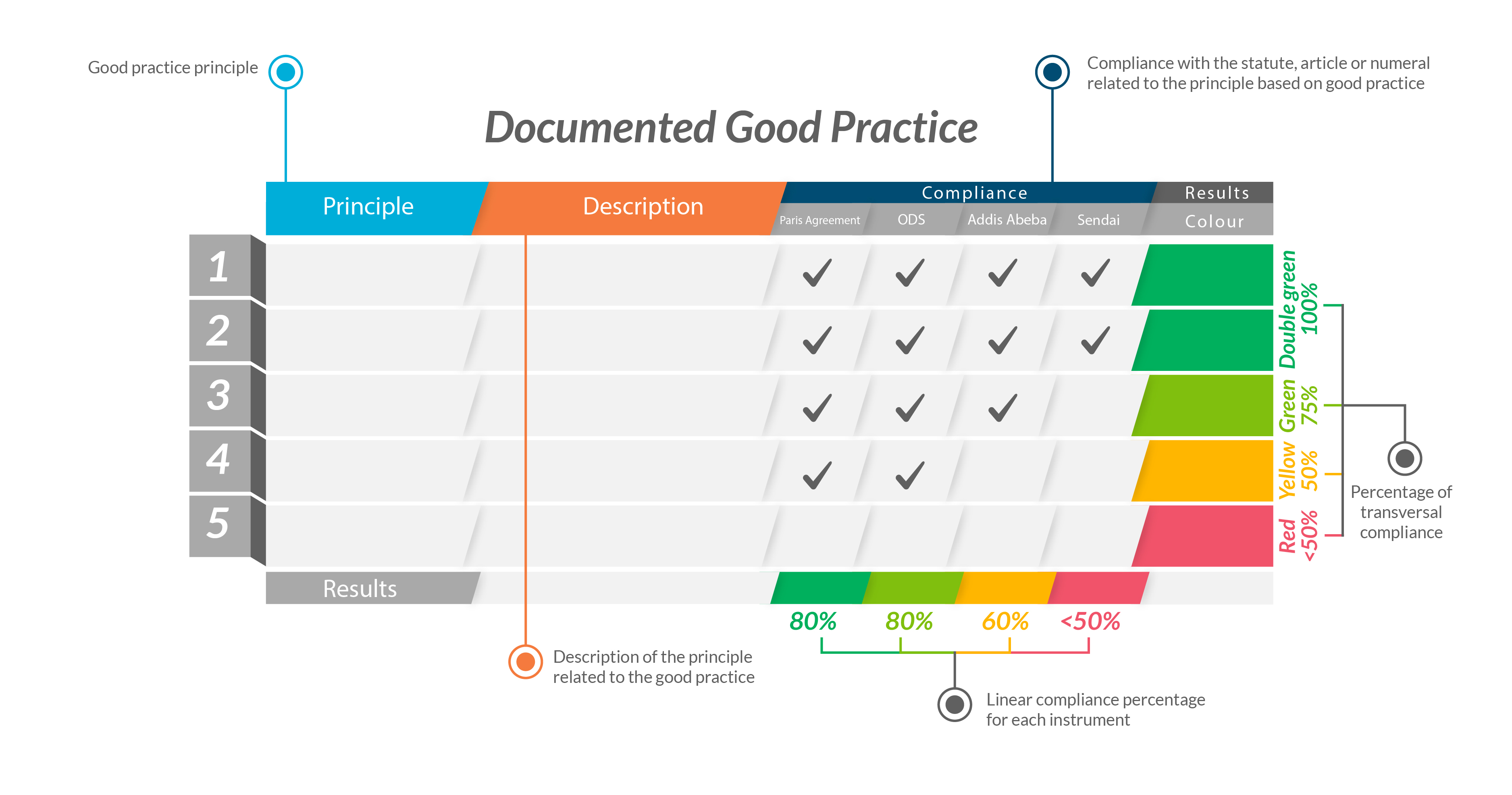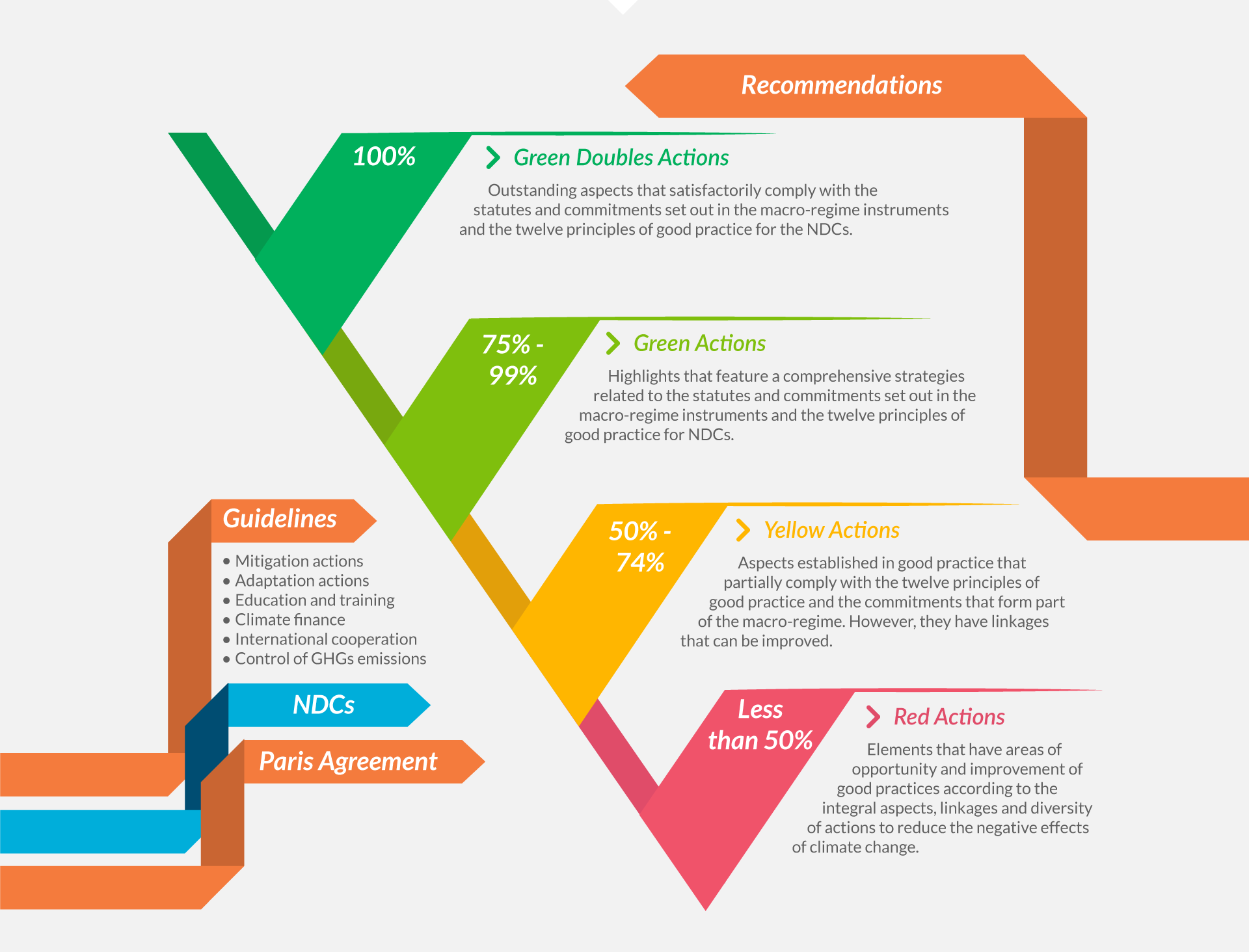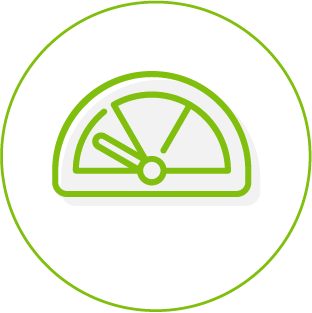Climate Traffic Light
Presentation
The concept of good practices of the macro-development regime and its
twelve principles requires a methodological strategy to facilitate the use
and operationalization of the concept, to be useful for LAC countries in the
identification of good practices for the NDCs.
Therefore, the concept and
its principles are a basis for the construction of a methodological tool
called the Climate Traffic Light. This tool is aimed to applying the concept of
good practices, its principles and analyzing the linkages between the different
instruments of the macro-regime to identify good practices and the main elements
that promote integral development from climate action.

Link between the macro-regime

Origin of the Climate Traffic Light
The climate traffic light considers that the NDCs are policy instruments to generate comprehensive actions that comply with the international commitments established in the other instruments that constitute the macro-regime, whose links are established through the statutes of each instrument.
The Paris Agreement establishes that the NDCs are the countries' main response strategy to address climate change, with each country communicating its long-term efforts to reduce the negative effects of climate change, promote sustainable development and eradicate poverty. Hence, the climate traffic light has its origin in the Paris Agreement. The main elements of the Agreement are integrated through a content analysis to identify the main aspects of each section, statute, objective and article that form the Paris Agreement.
Based on the above, the Paris Agreement was divided into six main sections that are the basis for the structure of the Climate Stoplight:

GHG emissions control.

Climate change mitigation actions.

Climate change adaptation actions./p>

Education and training on climate change issues.

Climate finance sources.

International cooperation actions and spaces for dialogue for the exchange of experiences.
Climate traffic light
Climate Traffic Light Structure
Each principle that makes up a good practice is linked to the contents of the Paris Agreement to generate different criteria that respond to each commitment established in the Agreement. Thus, the climate traffic light is structured in 47 elements or criteria that integrate the twelve principles of good practice, the statutes of the Paris Agreement and the functionality of the NDC as an instrument for climate action.
Finally, based on the statutes of the instruments that make up the macro-regime, each criterion is linked to the other instruments, generating a list of statutes and articles that support the potential of the NDC to promote comprehensive actions that not only respond to the compliance with an international instrument, but with others that are indirectly related.
Frequently asked questions
It arises from the need to have an operational concept of good practices for climate action, which leads to the need for a tool to identify and analyse them.
The Climate Stoplight can be used to analyse any type of climate change mitigation or adaptation project, climate action initiative, or climate policy.
The Climate Stoplight allows the analysis of climate change projects, initiatives or policies regardless of their stage. It can be implemented during the planning, execution or evaluation phase. It all depends on the objective of the analysis and the way in which the results are interpreted.
Yes, the Stoplight can be a short or medium-term evaluation tool to detect areas of opportunity or continuous improvement.
Partial results or expected results can be used, the important thing is that this aspect is considered during the interpretation of results.
The focus of the analysis will depend on the objectives, scope and interests of the institution conducting the analysis. If the project is to be analysed based on some element or component, the principles-based approach is the best. On the other hand, if the interest of the analysis is focused on a particular commitment or convention, the macro-regime approach is the most appropriate.
The difference is the form of analysis. The principles-based approach assesses a particular aspect that relates to the six macro-regime instruments, while the macro-regime approach assesses an instrument through the twelve principles of good practice.
Ideally, the analysis should be carried out in full, i.e. with all the instruments that are part of the macro-regime. This is due to the fact that depending on the call or donor there are financing interests, the best thing to do is to have a complete result of the traffic light.
Yes, but it does not mean that donors use it as a method for selecting proposals. The Stoplight allows us to evaluate an initiative to be presented in order to find areas of opportunity and better before presenting it.
All institutions will have free access to the Climate Stoplight tool and the databases generated, such as catalogues and best practice directories.
There will be different training cycles and even specific capacity building programs according to the interest of the institutions.
Source: Water Program of the Department of Sustainable Development of the Executive Secretariat for Integral Development (SEDI-DDS) of the General Secretariat of the Organization of American States (GS/OAS).


















